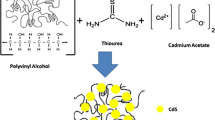Abstract
In situ preparation of polyvinyl alcohol (PVA) films doped with cadmium sulfide (CdS) nanoparticles was conducted by gamma radiation. The films were characterized in terms of photoluminescence and electrical conductivity. The photoluminescence results indicated the existence of two emission peaks around 470 and 530 nm, which are due to electron–hole recombination of CdS nanoparticles and surface trapped emission due to the PVA capping, respectively. DC electrical conductivity (σ DC) measurement in the temperature range from 303 up to 373 K reveals an increase in its value with increasing both Cd2+ ion molar concentration and irradiation dose. AC electrical conductivity (σ AC) measurement over the same temperature range at an applied field frequency of 10, 100, 500 and 1000 kHz shows an increase behavior with increasing temperature, frequency, Cd2+ ion molar concentration and irradiation dose. Dielectric constant (ε 1) exhibits an increase with temperature, whereas it shows reduced values with increasing frequency, Cd2+ ion molar concentration and irradiation dose. Also, the dielectric loss tangent (tan δ) follows an increasing trend with increasing temperature, Cd2+ ion molar concentration and irradiation dose while it has an opposite trend with increasing frequency. The CdS/PVA nanocomposite films behavior could be explained on the basis of formation of charge-transfer complexes (CTCs) by the CdS nanoparticles doped into the PVA matrix and the role of radiation in enhancing the charge carrier mobility of such CTCs.








Similar content being viewed by others
References
S. Tiwari, S. Tiwari, Cryst. Res. Technol. 41, 78–82 (2006)
R. Seoudi, A.B. El-Bailly, W. Eisa, A.A. Shabaka, S.I. Soliman, R.K. Abd El Hamid, R.A. Ramadan, J. Appl. Sci. Res. 8(2), 658–667 (2012)
L. Shen, Y. Fang, H. Wei, Y. Yuan, J. Huang, Adv. Mater. 28, 2043–2048 (2016)
G. Jin, L.-M. Jiang, D.-M. Yi, H.-Z. Sun, H.-C. Sun, ChemPhysChem 16, 3687–3694 (2015)
A. Reisch, A.S. Klymchenko, Small (2016). doi:10.1002/smll.201503396
T. Radhakrishnan, M.K. Georges, P.S. Nair, A.S. Luyt, V. Djokovic, Colloid Polym. Sci. 286, 683–689 (2008)
J.C. Ferrer, A. Salinas-Castillo, J.L. Alonso, S. Fernández de Ávilaam, R. Mallavia, Phys. Procedia 2, 335–338 (2009)
D. Saikia, P.K. Saikia, P.K. Gogoi, P. Saikia, Dig. J. Nanomater. Biostruct. 6, 589–597 (2011)
C.J. Murphy, Anal. Chem. 47(A), 520–526 (2002)
P.D. Cozzoli, T. Pellegrino, L. Manna, Chem. Soc. Rev. 35, 1195–1208 (2006)
G. Schmid, B. Coran, Eur. J. Inorg. Chem. 17, 3081–3098 (2003)
Z.I. Ali, O. Ebraheem, H.H. Saleh, F.H. Abd Salam, R. Sokary, Polym. Eng. Sci. (2015). doi:10.1002/pen.24151
Q. Xia, X. Chen, K. Zhao, J. Liu, Mater. Chem. Phys. 111, 98–105 (2008)
Y. Cai, X. Wu, Q. Liu, H. Liu, J. Appl. Polym. Sci. (2016). doi:10.1002/APP.43227
R.F. Bhajanti, V. Ravindrachary, A. Harisha, G. Ranganathaiah, G.N. Kumaraswamy, Appl. Phys. A 87, 797–805 (2007)
S. Mahendia, A.K. Tomar, S. Kumar, J. Alloys Compd. 508, 406–411 (2010)
V. Raja, A.K. Sharma, V.V.R.N. Rao, Mater. Lett. 58, 3242–3247 (2004)
J.M. Stevels, The Electrical Properties of Glass, Handbuch der Physik (Springer, Berlin, 1957), p. 350
M.H. Harun, E. Saion, A. Kassim, M.Y. Hussain, I.S. Mustafa, M.A.A. Omer, Malays. Polym. J. 13(2), 24–31 (2008)
V.S. Sangawar, R.J. Dhokne, A.U. Ubale, P.S. Chikhalikar, S.D. Meshram, Bull. Mater. Sci. 30(2), 163–166 (2007)
C.U. Devi, A.K. Sharma, V.V.R.N. Rao, Mater. Lett. 56, 167–174 (2002)
A. Kiesow, J.E. Morris, C. Radehaus, A. Heilmann, J. Appl. Phys. 94, 6988–6990 (2003)
Acknowledgments
The authors would like to thank the Science and Technology Development Fund (STDF), Egypt, for their financial support under the Grant Number (6370). The authors would like also to express their thanks to Ms. R. Sokkary for her help in preparing the PVA films.
Author information
Authors and Affiliations
Corresponding author
Rights and permissions
About this article
Cite this article
Ali, Z.I., Hosni, H.M., Saleh, H.H. et al. Photoluminescence and electrical properties of polyvinyl alcohol films doped with CdS nanoparticles. Appl. Phys. A 122, 514 (2016). https://doi.org/10.1007/s00339-016-0037-4
Received:
Accepted:
Published:
DOI: https://doi.org/10.1007/s00339-016-0037-4




